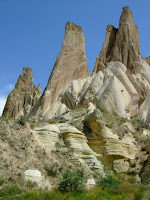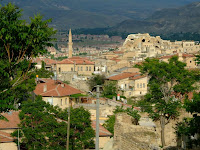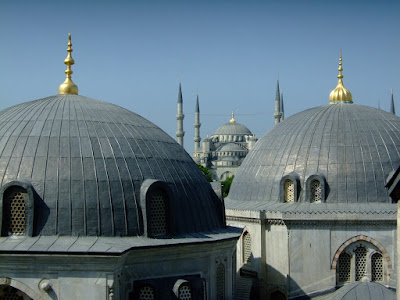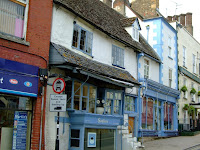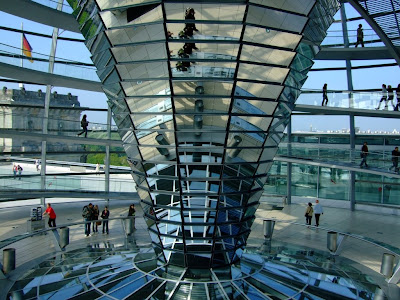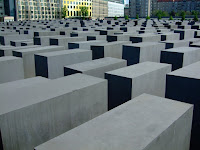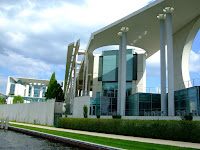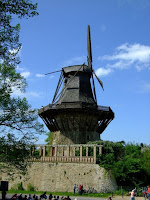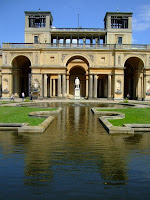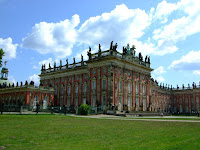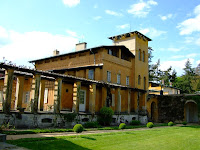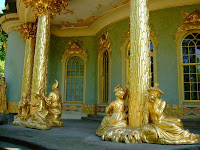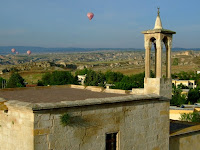 The roar from the burners of hot-air balloons encouraged us outside on a beautiful morning to see the colourful spectacle of 17 parties of tourists having an amazing view of the Capadoccian formations as they glided slowly along the valleys in their balloons.
The roar from the burners of hot-air balloons encouraged us outside on a beautiful morning to see the colourful spectacle of 17 parties of tourists having an amazing view of the Capadoccian formations as they glided slowly along the valleys in their balloons. We were collected by a new guide and taken to the Goreme Open Air Museum. This complex was once a theological training school with a number of churches; a multi-story Nunnery; and a multi-storey Monastery all carved out of the soft rock and fairy chimneys. Compared to yesterday the tourist hordes and queues were a tad tiresome but the waits were worth it to see the amazing frescos in some of the churches.
We were collected by a new guide and taken to the Goreme Open Air Museum. This complex was once a theological training school with a number of churches; a multi-story Nunnery; and a multi-storey Monastery all carved out of the soft rock and fairy chimneys. Compared to yesterday the tourist hordes and queues were a tad tiresome but the waits were worth it to see the amazing frescos in some of the churches. A couple of viewpoints followed: A panoramic view over Pigeon Valley with its many fairy chimney dwellings; and then a look at Uchisar Castle. The castle is, again, an outcrop of tufa stone that had been converted in to a multi-storey “apartment block” with 12-15 rooms per family. Understandably, they were not best pleased when the government moved them all out to new, modern 4-5 room dwellings after a major rock collapse killed a number of those living in the cave homes.
A couple of viewpoints followed: A panoramic view over Pigeon Valley with its many fairy chimney dwellings; and then a look at Uchisar Castle. The castle is, again, an outcrop of tufa stone that had been converted in to a multi-storey “apartment block” with 12-15 rooms per family. Understandably, they were not best pleased when the government moved them all out to new, modern 4-5 room dwellings after a major rock collapse killed a number of those living in the cave homes.As we had a different guide and tour party today, we ended up back at the same Jewellery factory as yesterday. We skipped the repeat visit and had a walk around Uchisar instead.
 Lunch was an amazing affair in a restaurant (Uranus) carved out of the rock. The speciality is a dish called Guvec, which is meat, peppers, tomatoes, spices etc cooked in an earthenware jug which is covered with a tile lid, sealed on with bread dough and slowly cooked for 3 hours. A great production is made of the jar being wheeled to the table and the chef breaking open the dough seal and serving the contents: an experience not to be missed, if you are in the vicinity of Avanos.
Lunch was an amazing affair in a restaurant (Uranus) carved out of the rock. The speciality is a dish called Guvec, which is meat, peppers, tomatoes, spices etc cooked in an earthenware jug which is covered with a tile lid, sealed on with bread dough and slowly cooked for 3 hours. A great production is made of the jar being wheeled to the table and the chef breaking open the dough seal and serving the contents: an experience not to be missed, if you are in the vicinity of Avanos. It was time for another commercial, so we visited a pottery on the banks of the Red River at Avanos. There are abundant supplies of red clay from the river and white clay from the surrounding hills and, together with the wonderfully detailed hand-painted patterns; the potteries here turn out a colourful selection of ceramic ware. We were particularly taken with a Hittite styled wine jug (possibly called Halkali Ibrik) that was basically a big donut with a base added and a handle/spout attached to the top. However at YTL3300, bargained down to YTL2400, we left it on the shelf.
It was time for another commercial, so we visited a pottery on the banks of the Red River at Avanos. There are abundant supplies of red clay from the river and white clay from the surrounding hills and, together with the wonderfully detailed hand-painted patterns; the potteries here turn out a colourful selection of ceramic ware. We were particularly taken with a Hittite styled wine jug (possibly called Halkali Ibrik) that was basically a big donut with a base added and a handle/spout attached to the top. However at YTL3300, bargained down to YTL2400, we left it on the shelf.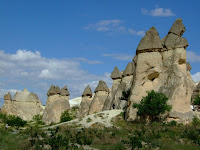 Back in the real world we stopped at Monk’s Valley to wander amongst the fantastical fairy chimneys with their conical basalt tops that do look like a bunch of monks in their hoods hustling across the landscape, but forever frozen in time.
Back in the real world we stopped at Monk’s Valley to wander amongst the fantastical fairy chimneys with their conical basalt tops that do look like a bunch of monks in their hoods hustling across the landscape, but forever frozen in time. Smaller formations that are equally surreal were to be seen at our final stop, the Derwent Valley. Looking like something out of science fiction, it is no wonder that this area has featured in films such as Star Wars.
Smaller formations that are equally surreal were to be seen at our final stop, the Derwent Valley. Looking like something out of science fiction, it is no wonder that this area has featured in films such as Star Wars.Back at Urgup we had a hour to fill before our next overnight odyssey, this one 13 hours to Izmir, so we wandered the shops and were, as is normal, accosted by the traders in an effort to
 get us into their shops. Succumbing to the charms of Oktay at Elmas Cini we saw that he had a beautiful Halkali Ibrik in traditional Hittite patterns and colours, the same size as the one we had seen at Avanos for a much more acceptable price. Complete with a 32cm dish to stand it on, we left with our wallet only YTL260 (£122.38) lighter – a saving of £860 over the tourist-trap prices.
get us into their shops. Succumbing to the charms of Oktay at Elmas Cini we saw that he had a beautiful Halkali Ibrik in traditional Hittite patterns and colours, the same size as the one we had seen at Avanos for a much more acceptable price. Complete with a 32cm dish to stand it on, we left with our wallet only YTL260 (£122.38) lighter – a saving of £860 over the tourist-trap prices.

